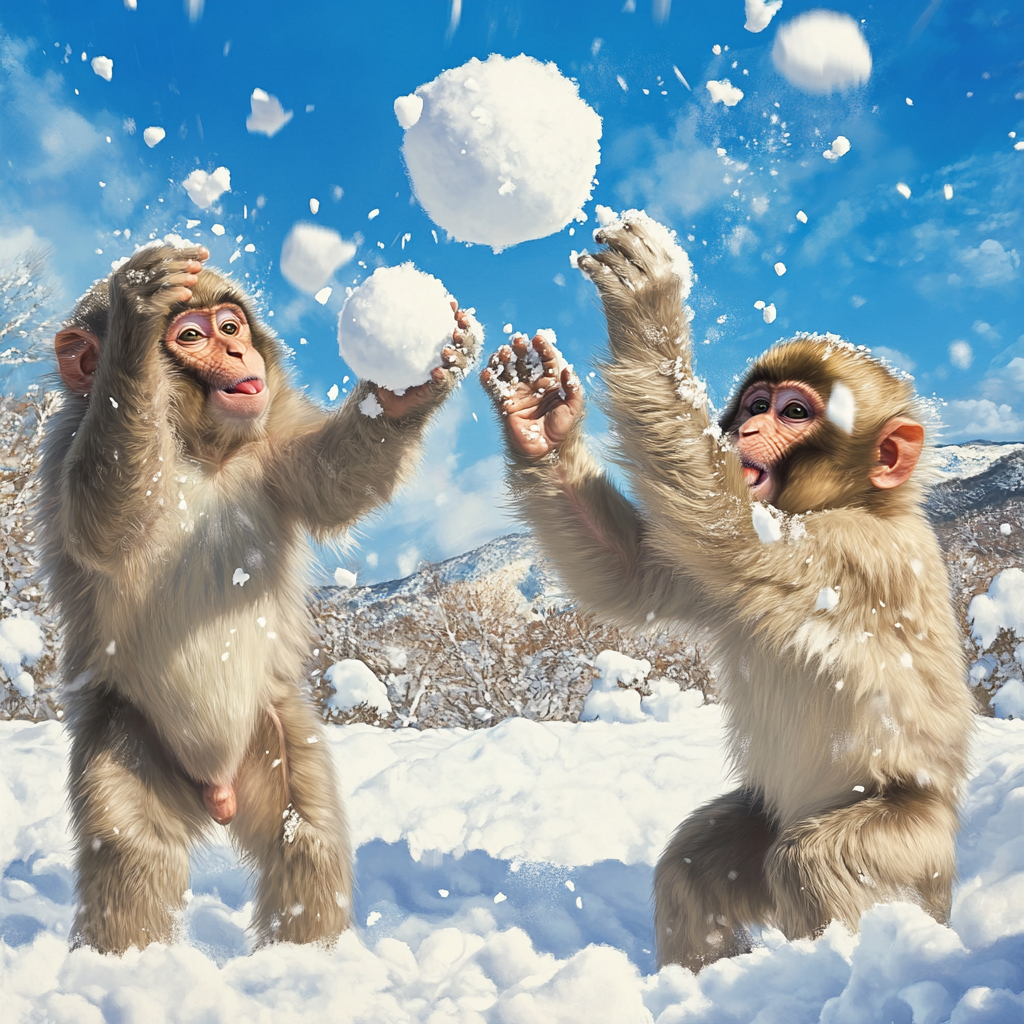
Japanese macaques (Macaca fuscata), also known as snow monkeys, are famous for their adaptability to cold environments and for their playful nature, which includes making snowballs. They are native to Japan and are well known for their thick fur and remarkable behavior, especially in winter when they inhabit snowy regions. Here’s the true story and fascinating facts about how Japanese macaques make snowballs just for fun:
The Unique Behavior of Making Snowballs
Japanese macaques are the northernmost-living non-human primates and have adapted to survive in snowy conditions. One of the behaviors they have been observed engaging in is making snowballs, which they roll around and even play with.
- Observation of Snowball Making:
- The first recorded observations of Japanese macaques making snowballs were made by primatologists and researchers studying the behavior of macaques in the Jigokudani Monkey Park in Nagano, Japan.
- During the winter months, these monkeys were seen picking up snow, packing it together, and rolling it into a ball. They appear to do this for no functional reason, just for the fun of it. This behavior is similar to how human children play in the snow.
- Playful Behavior:
- Snowball-making is an example of play behavior among Japanese macaques. Play is an important part of their lives and has multiple functions, including social bonding and mental stimulation.
- This activity doesn’t serve an apparent practical purpose like building shelter or finding food, but it is an expression of curiosity and playfulness, which helps strengthen social ties within the group.
- Rolling and Tossing Snowballs:
- Younger macaques, in particular, are the ones most commonly seen making snowballs. They have been observed rolling snowballs, tossing them around, and sometimes even stealing each other’s snowballs, which can lead to chasing games.
- The fact that macaques create and play with snowballs just for the enjoyment of it is remarkable because it demonstrates a level of cognitive complexity and creativity not often seen in animals.
Why Do Japanese Macaques Make Snowballs?
The behavior of snowball-making is thought to have several purposes:
- Mental Stimulation:
- In the cold winter months, when food is scarcer and there are fewer opportunities for exploration, making snowballs can serve as a form of mental stimulation. It helps the macaques remain engaged with their environment.
- Social Learning and Interaction:
- Snowball-making is often seen among juveniles, suggesting it could be a way to practice motor skills and learn about the properties of their environment. It also encourages interaction between young macaques, promoting social bonding.
- Some researchers have observed that snowball-making and playing with snow appears to be a learned behavior, with younger macaques mimicking others. This demonstrates that such play may have a social component, where young monkeys learn and adopt behaviors by watching older individuals.
- Reducing Stress:
- Like many other forms of play, making snowballs may help reduce stress and provide a form of entertainment for these macaques. Engaging in playful activities has been shown in many animal species to have calming and relaxing effects.
Playful Behavior in Japanese Macaques
Japanese macaques are known for their playful personalities and their ability to adapt to their environment. Aside from making snowballs, they are also famous for several other behaviors:
- Bathing in Hot Springs:
- Japanese macaques are well known for their behavior of bathing in hot springs (onsen) during the winter to keep warm. This behavior was first observed at the Jigokudani Monkey Park, where macaques regularly bathe in natural hot springs to regulate their body temperature.
- The bathing behavior is primarily seen in colder regions, where temperatures can drop significantly. The hot springs provide a means of thermoregulation that helps them endure the cold winter months.
- Stone Handling:
- Another unique behavior exhibited by Japanese macaques is stone handling. They pick up stones, roll them, rub them together, and even stack them. This behavior is believed to have a cultural aspect, passed down from generation to generation, similar to how they engage in snowball-making.
- Food Washing:
- Japanese macaques have also been observed washing sweet potatoes in water before eating them. This behavior was first observed in the 1950s and spread through the troop as other macaques learned from those that initiated it. This food-washing behavior is another example of the cultural transmission of behaviors within macaque groups.
Intelligence and Social Complexity
The ability to create and play with snowballs highlights the intelligence and complexity of Japanese macaques:
- Complex Social Structure:
- Japanese macaques live in troops that have a complex social structure. There is a dominance hierarchy, with both male and female hierarchies determining access to resources and mating opportunities.
- Play behavior, including snowball-making, is an important part of establishing social relationships within the troop, particularly for younger macaques.
- Learned Behavior:
- The fact that juvenile macaques are more likely to make snowballs suggests that this is a learned behavior. Young macaques learn by observing and mimicking others, which demonstrates an advanced level of social learning.
- Curiosity and Problem Solving:
- Japanese macaques are highly curious animals and are known for their problem-solving skills. This curiosity extends to their natural environment, where they explore different materials and often come up with new ways to engage with them, like making snowballs or playing with stones.
Summary
The behavior of Japanese macaques making snowballs is a fascinating example of animal play that showcases their intelligence, curiosity, and adaptability. This playful activity, often seen among juveniles, helps provide mental stimulation, strengthen social bonds, and offer a form of entertainment during the cold winter months.
Snowball-making, along with other unique behaviors like bathing in hot springs and stone handling, highlights the complex and rich behavioral repertoire of these monkeys. It demonstrates that Japanese macaques are not only highly intelligent animals but also capable of engaging in activities that appear to be purely for fun, much like humans. Their remarkable adaptability and intriguing behaviors make them one of the most well-studied and beloved primates in the world







